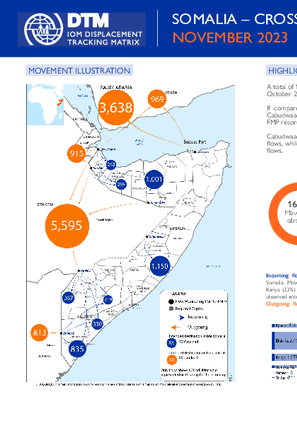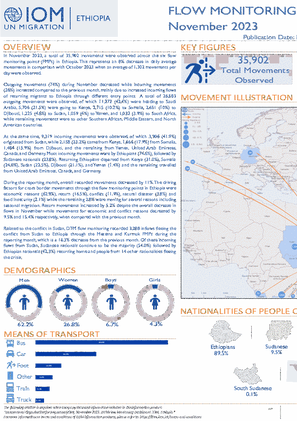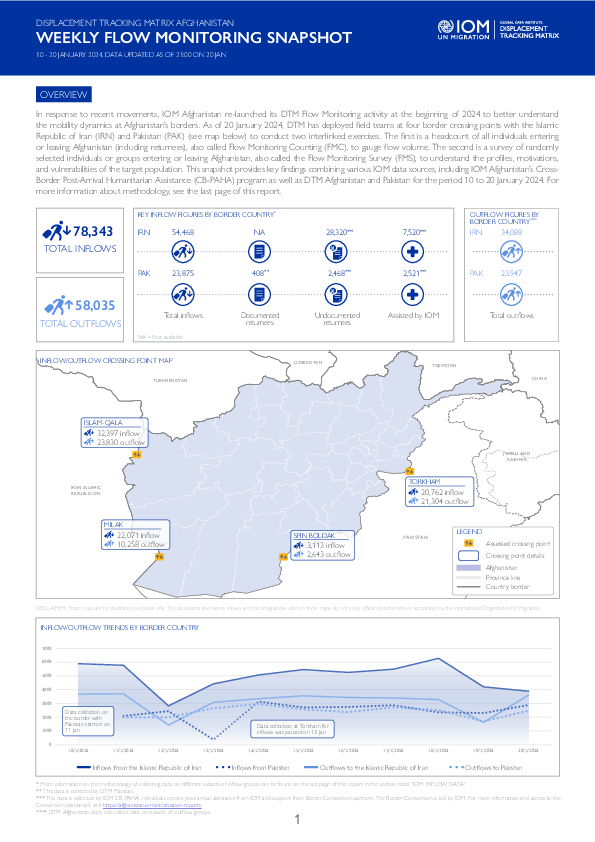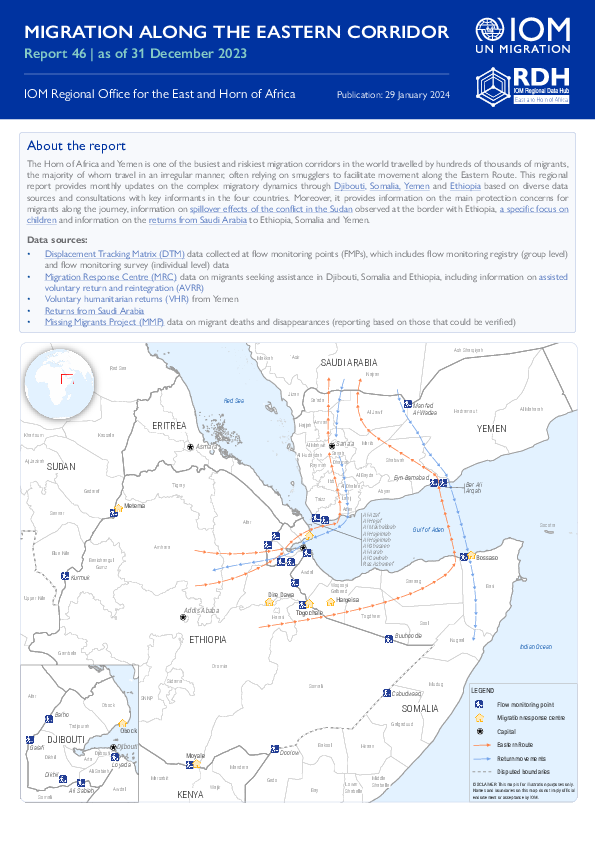-
Countries
-
Data and Analysis
-
Special Focus
-
Crisis Responses
Flow Monitoring
Domain host
migration.iom.int

Contact
DTM Europe, DTMMediterranean@iom.int
Language
English
Location
Serbia
Period Covered
Dec 15 2023
Dec 29 2023
Activity
- Survey
- Flow Monitoring
This report provides insights into the profiles, experiences and journeys of migrants transiting through the Republic of Serbia. Data was collected from 15 to 29 December 2023 together with the Commissariat for Refugees and Migrants of the Republic of Serbia (SCRM). Total of 112 migrants were interviewed in six centres (AC Banja Koviljaca, RC Pirot, AC Obrenovac, RC Bujanovac, AC Krnjaca, RC Presevo) across the country.

Contact
DTM Somalia, IOMSomaliaDTM@iom.int
Language
English
Location
Somalia
Period Covered
Nov 01 2023
Nov 30 2023
Activity
- Survey
- Flow Monitoring Survey
- Flow Monitoring
A total of 16,614 movements were observed in November 2023, representing a 37% decrease compared to October 2023 when 26,352 movements were observed during this period. If compared with October 2023, Doolow (-60%), Dhobley (-41%), Harirad (-26%), Bossaso (-4%), Cabudwaaq (-4%) and Lowyacado (-3%) FMPs recorded a decrease in movements while Buuhoodle (27%) FMP recorded an increase in movements. Cabudwaaq (25%), Dhobley (23%) and Doolow (17%) FMPs recorded the highest numbers of incoming flows, while Doolow (40%), Bossaso (39%) and Buuhoodle (7%) recorded the highest numbers of outgoing flows.

Contact
RDH Asia and the Pacific Support - rdhroapsupport@iom.int
Language
English
Location
Afghanistan
Period Covered
Aug 15 2021
Aug 15 2023
Activity
- Flow Monitoring
From when the reporting period started to where it ends, (15 August 2021 to 15 August 2023), the gap between total outflows and inflows has dwindled between Afghanistan and two of its neighbouring countries, that is the Islamic Republic of Iran and Pakistan.
By the second half of the reporting period, cross-border movements reached close to a 1 to1 ratio between outflows (4,307,755) and inflows (4,314,442).
Changes in these flows across this two year period may be more generally attributed to the combination of tighter governmental controls on border crossings, temporary border closures, and fear of deportations of Afghan nationals living abroad. The following sections point to notable peaks and downturns in mobility flows to help put into perspective the timeline and context in which IOM operates in.

Contact
DTM Ethiopia, DTMEthiopia@iom.int
Language
English
Location
Ethiopia
Period Covered
Nov 01 2023
Nov 30 2023
Activity
- Flow Monitoring
In November 2023, a total of 35,902 movements were observed across the six flow monitoring points (FMPs) in Ethiopia. This represents an 8% decrease in daily average movements in comparison with October 2023 when an average of 1,302 movements per day were observed.
Outgoing movements (74%) during November decreased while incoming movements (26%) increased compared to the previous month, mainly due to increased incoming flows of returning migrants to Ethiopia through different entry points. A total of 26,583 outgoing movements were observed, of which 11,272 (42.4%) were heading to Saudi Arabia, 5,706 (21.5%) were going to Kenya, 2,715 (10.2%) to Somalia, 2,651 (10%) to Djibouti, 1,225 (4.6%) to Sudan, 1,059 (4%) to Yemen, and 1,032 (3.9%) to South Africa, while remaining movements were to other Southern African, Middle Eastern, and North American countries.
At the same time, 9,319 incoming movements were observed, of which 3,906 (41.9%) originated from Sudan, while 2,158 (23.2%) came from Kenya, 1,666 (17.9%) from Somalia, 1,484 (15.9%) from Djibouti, and the remaining from Yemen, United Arab Emirates, Canada, and Germany. Most incoming movements were by Ethiopians (74.6%), followed by Sudanese nationals (23.8%). Returning Ethiopians departed from Kenya (31.0%), Somalia (24.0%), Sudan (22.5%), Djibouti (21.1%), and Yemen (1.4%) and the remaining travelled from United Arab Emirates, Canada, and Germany.

Contact
DTM Ethiopia, DTMEthiopia@iom.int
Language
English
Location
Ethiopia
Period Covered
Jun 01 2023
Jun 30 2023
Activity
- Flow Monitoring
In order to increase the availability of evidence on rural to urban migration flows and trends, as well as needs, coping mechanisms and motivations of drought-affected persons, the International Organization for Migration (IOM) Data and Research Unit (DRU), through the Displacement Tracking Matrix (DTM) methodology, set up two internal Flow Monitoring Points (FMPs) in Gode and Jigjiga, two major urban centres in the Somali region of Ethiopia.
This dashboard focuses on data collected in June 2023 through the Flow Monitoring Registry (FMR) tool in Gode and Jigjiga FMPs. In June 2023, 11,228 movements were observed, 7,006 of which were through Gode FMP (62.40%) and 4,222 through Jigjiga FMP (37.60%).
Contact
DTM Pakistan, DTMPakistan@iom.int
Location
Pakistan
Activity
- Survey
- Flow Monitoring
Period Covered
Jan 01 2023 -Dec 31 2023
The International Organization for Migration (IOM) in Pakistan collects data on the outflows of Afghans at the Torkham (Khyber Pakhtunkhwa) and Chaman (Balochistan) border crossing points (BCPs) to better understand the movements of Afghans returning to Afghanistan. The dataset is harmonised with those from the United Nations High Commissioner for Refugees (UNHCR), who also cover Ghulam Khan (Khyber Pakhtunkhwa), Badini and Bahramcha (Balochistan).
A more detailed version of this dataset containing information about the vulnerabilities is available, to get access kindly click on the 'Request Access' button
Population Groups
Returnee (Previously Displaced Abroad)
Survey Methodology
Unit of Analysis Or Observation
Other
Type of Survey or Assessment
Keywords
Geographical Scope
Administrative boundaries with available data
The current dataset covers the following administrative boundaries

Contact
DTMAfghanistan@iom.int
Language
English
Location
Afghanistan
Period Covered
Feb 21 2024
Feb 27 2024
Activity
- Survey
- Flow Monitoring Survey
- Flow Monitoring
In response to recent movements, IOM Afghanistan re-launched its DTM Flow Monitoring activity at the beginning of 2024 to better understand the mobility dynamics at Afghanistan’s borders. Since 10 January, DTM has deployed field teams at four border crossing points with the Islamic Republic of Iran (IRN) and Pakistan (PAK) (see map below) to conduct two interlinked exercises. The first is a headcount of all individuals entering or leaving Afghanistan (including returnees), also called Flow Monitoring Counting (FMC), to gauge flow volume. The second is a survey of randomly selected individuals or groups entering or leaving Afghanistan, also called the Flow Monitoring Survey (FMS), to understand the profiles, motivations, and vulnerabilities of the target population. This snapshot provides key findings combining various IOM data sources, including IOM Afghanistan’s Cross-Border Post-Arrival Humanitarian Assistance (CB-PAHA) program as well as DTM Afghanistan and Pakistan for the period 21 to 27 January 2024. For more information about methodology, see the last page of this report.

Contact
DTMAfghanistan@iom.int
Language
English
Location
Afghanistan
Period Covered
Jan 10 2024
Jan 20 2024
Activity
- Survey
- Flow Monitoring Survey
- Flow Monitoring
In response to recent movements, IOM Afghanistan re-launched its DTM Flow Monitoring activity at the beginning of 2024 to better understand the mobility dynamics at Afghanistan’s borders. Since 10 January, DTM has deployed field teams at four border crossing points with the Islamic Republic of Iran (IRN) and Pakistan (PAK) (see map below) to conduct two interlinked exercises. The first is a headcount of all individuals entering or leaving Afghanistan (including returnees), also called Flow Monitoring Counting (FMC), to gauge flow volume. The second is a survey of randomly selected individuals or groups entering or leaving Afghanistan, also called the Flow Monitoring Survey (FMS), to understand the profiles, motivations, and vulnerabilities of the target population. This snapshot provides key findings combining various IOM data sources, including IOM Afghanistan’s Cross-Border Post-Arrival Humanitarian Assistance (CB-PAHA) program as well as DTM Afghanistan and Pakistan for the period 10 to 20 January 2024. An interactive dashboard on all data collected since the inception of the Flow Monitoring activity on 10 January can be found HERE.
The Horn of Africa and Yemen is one of the busiest and riskiest migration corridors in the world travelled by hundreds of thousands of migrants, the majority of whom travel in an irregular manner, often relying on smugglers to facilitate movement along the Eastern Route. This regional report provides monthly updates on the complex migratory dynamics through Djibouti, Somalia, Yemen and Ethiopia based on diverse data sources and consultations with key informants in the four countries. Moreover, it provides information on the main protection concerns for migrants along the journey, information on the spillover effects of the conflict in the Sudan observed at the border with Ethiopia, a specific focus on children and information on the returns from Saudi Arabia to Ethiopia, Somalia and Yemen.

Contact
iombuenosaires@iom.int
Language
Spanish
Location
Argentina
Period Covered
Aug 01 2023
Sep 30 2023
Activity
- Survey
- Flow Monitoring Survey
Actualmente, se estima que aproximadamente 7, 7 millones de personas de nacionalidad venezolana se encuentran fuera de la República Bolivariana de Venezuela1 , de las cuales 6.5 millones residen en países de América Latina y el Caribe. En la República Argentina, residen más de 200.000 personas venezolanas , siendo este flujo poblacional uno de los más dinámicos en años recientes en un país históricamente receptor de inmigración. La magnitud de este movimiento de población resulta inédita en la historia reciente de América Latina y el Caribe e involucra tanto a refugiados como migrantes de aquel país.
La experiencia demuestra que los movimientos poblacionales a gran escala persisten y se pueden complejizar en ausencia de soluciones políticas y solidaridad internacional continua. Dada la magnitud de la salida de personas venezolanas, solo un enfoque integral y coordinado a nivel regional entre los gobiernos, con el apoyo de la comunidad internacional, permitirá a la región hacer frente a la magnitud de este influjo.
Con este objetivo en mente, el Plan Regional de Respuesta para Refugiados y Migrantes Venezolanos (RMRP, por sus siglas en inglés) se ha desarrollado para apoyar y complementar la labor de las autoridades nacionales de América Latina y el Caribe, respondiendo a las necesidades de la población de manera integral y exhaustiva y en el marco de los mecanismos regionales de respuesta y coordinación.
Desde 2018 OIM Argentina ha implementado la Matriz de Seguimiento del Desplazamiento (DTM, por sus siglas en inglés) en su modalidad de Encuesta de Monitoreo de Flujos (en diversos puntos de ingreso al territorio nacional y de estancia). La DTM es un sistema para monitorear movimientos de población y cuenta con una variedad de herramientas de medición.
Cada una de ellas puede ser adaptada para dar seguimiento de forma sistemática y regular al desplazamiento de personas en diversos contextos. Su objetivo principal consiste en conocer el perfil y mejorar la comprensión de las necesidades de la población que se moviliza en diferentes situaciones.
Desde 2018, la implementación de la DTM en la República Argentina ha tenido como objetivos: caracterizar a la población venezolana que arriba o que reside en el país, para conocer sus aspectos sociodemográficos, las rutas recorridas, su situación migratoria, laboral, sus posibilidades de acceso a la salud, a los alimentos, a la vivienda y a la información. También se indaga acerca de las necesidades concretas de asistencia y sobre los procesos de reunificación familiar que las personas encuestadas consideran experimentarán en el corto o mediano plazo. La DTM ronda 15 se realizó durante los meses de agosto y septiembre de 2023. Las encuestas se aplicaron en la Ciudad Autónoma de Buenos Aires, Ciudad de Córdoba (Córdoba) y Rosario (Santa Fe).
Pagination
- Previous page
- Page 27
- Next page
